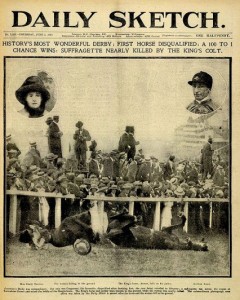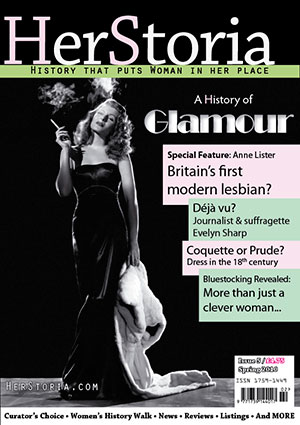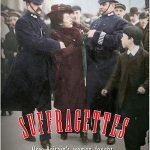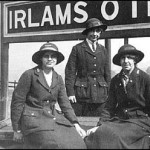Davies and Davison
Is commemoration a matter of deeds versus words?
Table of Contents
We want to consider why Davies is seemingly forgotten in comparison to Davison in our collective memory of the women’s rights movement. Despite both being feminists and members of organisations striving to advance the status of women in Britain in the nineteenth and twentieth centuries, only Davison symbolises the entire movement simply because she is perceived to have died for the cause.
To understand why Davison is remembered more than Davies, we must look at the situation faced by women in the nineteenth century, where the liberties women can expect today appeared unattainable.
The rise of the women’s rights movement
At the time, women were mostly excluded from higher education, confined to the home and, above all, denied the right to vote in national elections; middle and upper class female rights groups emerged from these limitations in the 1860s. These women were radical, educated and determined to make a difference in improving the conditions of women’s lives and education. Two campaigning groups for women’s franchise were formed: first women suffragists, and at the start of the twentieth century the suffragettes.
The suffragettes, the Women’s Social and Political Union (WSPU) developed new militant methods to agitate for female suffrage. Notorious for window breaking, arson, and enduring repeated forced feedings and arrests, these women take centre stage in the memory of the suffrage movement. Theresa Garnett, a member of the WSPU, was even sentenced to a month’s imprisonment after whipping Churchill with a riding-switch as he left a railway carriage in Bristol, 1909.
The aim of the suffragists, the National Union of Women’s Suffrage (NUWSS), was to improve the overall conditions of women. For instance they sought to enable female access to medical degrees and to improve women’s property rights. They sometimes disapproved of the violent actions of the suffragettes andinstead sought change via constitutional means including peaceful debate, demonstrations and petitions. Their argument was often articulated in terms of ‘good’ citzenship: suffragist Millicant Fawcett asked if women who broke the law could be considered good potential citizens worthy of the vote? Despite the eventual success of both groups, only one remains in the public domain – the suffragettes, whose members included the martyred Davison. In contrast, suffragists such as Davies who waged constitution campaigns are cast in their shadow. Do we then commemorate Davies less than Davison because the former chose not to live by ‘deeds not words’ - the motto of the suffragettes?
Davies was a member of countless committees and unions seeking the advancement of the position of women; she was an organised lobbyist seeking change by peaceful and conservative methods. She was involved in improving women’s working conditions and opportunities, offering support to those wishing to enter typically male occupations. This included Elizabeth Garrett who was the first British woman to successfully complete a medical degree in the UK.
Famously, Davies focussed on securing opportunities for women in education, and co-founded Girton College, the first women’s college at Cambridge. Although women were not fully admitted for degrees by the University of Cambridge until 1947, Davies’s work was vital in the development of female education.
She also took part in the campaign for the enfranchisement of women, under the leadership of the NUWSS, serving for a short time as its secretary.
Conversely, Emily Davison was involved in militant campaigns as a member of the WSPU. She joined the group in 1906 and prior to her death was arrested numerous times for throwing iron balls through windows and setting fire to pillar boxes. She even hid in the crypt of the Houses of Parliament to be registered there in the 1911 census!
Davison clearly fulfilled her aim of drawing attention to the suffrage movement and injustice faced by women, following the WSPU’s motto ‘deeds not words’, whilst Davies acted differently, preferring to work behind the scenes in the numerous committees of the movement.
These women shared similar names and fought similar causes, yet clearly had different views on the method to advance women’s rights. So why is Davison remembered so vividly today, unlike the relatively ignored Davies?
Why do we remember Davison?

Daily Sketch image of Davison’s suicide
Davison sought to influence and benefit a wider range of people - literally to enfranchise all English women – whilst Davies’ work primarily benefitted the middle and upper classes. Her focus may have led us to be particularith our public memory, encouraging us to remember an all embracing figure instead.
Perhaps then, it has more to do with the fact that Davison enhanced her reputation as a militant activist with the perception that she had given her life for the cause. Public memory remembers those individuals who died for their beliefs; consider those leaders and war heroes who fell in battle. Davison is remembered as a martyr, whilst Davies is seen as a modest, conservative campaigner.
If we are to be brutally honest, Davison’s dramatic story may be regarded as a more interesting one to tell than the cautious and conventional approach of Davies to the suffrage campaign. Commemoration, it appears, emphasises individuals who strived against the established social order.
The ambiguity and mystery surrounding Davison’s death also adds to the story: did she intend sacrifice herself or pin WSPU flags to the horse? This we will never know.
What we do know is that Davison’s memory lives on with a gold plaque in the House of Commons erected by Tony Benn in 1999, three different memorials in her home town of Morpeth, Northumberland, as well as in Epsom at the hospital where she died. Undoubtedly, her memory is perpetuated because her death was captured on film. Anyone can easily access the moment she became a martyr, allowing us to remember her and the suffragettes.
Why do we not remember Davies?
Emily Davies’ room at Girton
It is clear that Davison is treated as a figurehead of the women’s movement, whilst Davies has drifted into obscurity. This is strange if one considers the commemoration given to Davies immediately after her death.
Following her death in 1921, Davies was in fact fondly remembered, particularly by staff, students and fellow suffragists at Girton College, Cambridge. Gradually her memory has been overshadowed by the more radical suffragettes. Even the college struggles to focus on her, with pictures of many influential women adorning the walls. Davies herself wished to avoid the limelight, possibly explaining the lack of commemoration she has received. She purposefully said her funeral should be a private affair and that her memoirs should remain unpublished following her death. Equally, Davies’s private documents suggested that it had been her wish that any commemorations of her should feature another feminist, Barbara Bodichon, in equal volume.
She rejected the chances to take on a more prominent, public role as Mistress of Girton; when she eventually accepted this post, it was because no other candidate could be found. Davies believed that her work within higher education made her controversial enough without being an attention seeking figure behind it.
Her lack of recognition; however, is unlikely to be rooted simply in her modesty. After all, to what extent can an individual actually choose how they are remembered after their death and subsequently how they are commemorated?
The wider commemoration of Davies and public memory today
The Emily Davies commemorative plaque
Southampton, Gateshead and London have all commemorated Davies through the use of blue plaques and Southampton Solent University has even named a hall of residence after her. Above all, Davies has been significantly commemorated at Girton College where a gold plaque and a courtyard have been dedicated in her honour. Overall, then, Davies’s commemoration appears to cover the significant geographical areas with which she was associated. Davies maintains a local relevance but she remains absent from the wider public’s memory, whilst Davison’s place as a martyr for the cause remains secure.
Undeniably, both individuals lived and worked in a period marked by dramatic social changes for the advancement of women’s rights and education. These are all basic rights that we take for granted today and yet they only came about as a result of the actions of many unacknowledged people. Whilst Davies’s work is clearly not unknown, she remains out of the public domain, perhaps as she had wished.
Is it right that an individual who made such a difference to the lives of women should be overlooked? After all, around half the people at British universities today are indebted to her for opening the gateway to educational equality. We cannot take away the significance of Davison to the women’s movement, and certainly don’t aim to, but she should perhaps be commemorated in context with other campaigners whose work was also vital, like Davies.
Recommended Reading
Daphne Bennett, Emily Davies and the Liberation of Women (1830-1921), (London: Andre Deutsch 1990)
Emily Davies, The Higher Education of Women (1866; new ed. 2001, Adamant)
June Purvis, ‘The Suffragette in Women’s History’ from Women’s History Review 14 (3-4) (2005), pp. 357-64
This article was written by an undergraduate research team at the University of Southampton, headed by Katherine Tzavalas - Claire Skilton, Shawney Murphy, Patrick Coffey, Richard Parfitt, Thomas Sherrington and Lauren Trumper.










Leave a Reply